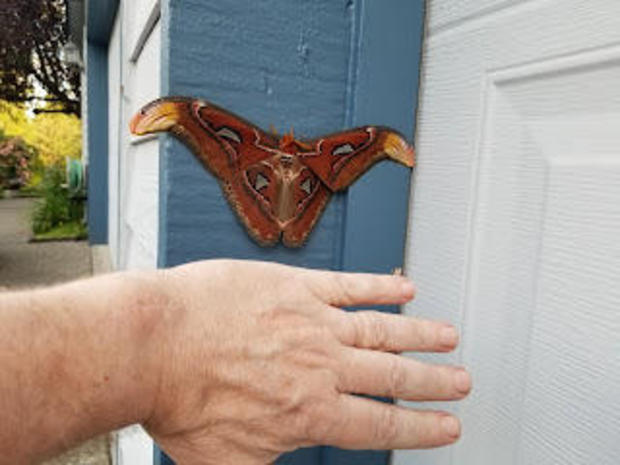Laboratory-bred bugs used to combat invasive species
A large moth with a wingspan of 10 inches was discovered in Washington state, but entomologists don't know how it got there. According to the Washington State Department of Agriculture, the Atlas moth is one of the largest moths in the world and is illegal to keep in the United States.
Little research has been done on this moth, but it is believed that it typically lives in tropical climates and feeds on apple and cherry plants according to a news release
``I don't know if I can survive here. We would like to enlist the help of the residents to find out if this was a one-off fugitive or if there is an actual population in the area."

Atlas moths are native to Southeast Asia andlive primarily in tropical and subtropical rainforests.
This moth he was discovered on July 7 by a professor at the University of Washington in Bellevue, brought to the WSDA, and sent to the WSDA by the US State Department. was sent to agricultural.
This is believed to be the first confirmed moth detection in the United States, and although it is unknown if there are more moths here, atlas moth populations are now in Washington. There is no evidence that the Entomologists in Washington State are urging the public to report sightings of Atlas moths.
"This is a 'Gee-wiz' type insect because it is so large," Spikiger said. "Even if you don't care about insects, this is the type where people pull out their phones and take pictures. They are very impressive."

Although they are large and conspicuous, they do not pose a danger to the public, so they can be safely collected and collected by humans who find them in the wild. processed.
But it is illegal to store them yourself, according to the State Department of Agriculture. It is illegal to obtain, store, raise, or sell live moths, whether adults, larvae, pupae, or eggs, unless authorized by the U.S. Department of Agriculture.
Photos and sightings of these moths can be sent to pepperprogram@agr.wa.govThere have been no reports of Atlas moths, however they have been seen outside of Washington. State Plant Regulator or State Plant Health Commissioner. } in your state.
CBS News said he has contacted the WSDA, USDA, the Washington Invasive Species Council, the US Forest Service and Spichiger and is awaiting a response.
The United States Forest Service, part of the USDA, tracksinvasive species and pests endemic to the United States. Invasive species are not endemic to the ecosystems they occupy. harm the economy, the environment, or human health;
The spotted lanternfly is an invasive species that recently made headlines. These insects are native to Asia, buthave been found in various regions of the Northeast, such asNew Jersey. Lanternphy can eat and kill about 70 types of vegetation and trees. It does no harm to people or animals, but authorities are urging anyone who sees it to crush and kill it to prevent its population from growing.
Invasion The killer wasp, or "Northern Giant Wasp," is native to Asia, but was spotted in Washington state earlier this year. They can inflict painful stings on humans, can grow over 2 inches in lengthand are also known to destroy beehives.
Nearly 1,000 wasp traps were set up in Whatcom County earlier this year, where murderous wasps were identified. I was.
If invasive species are not addressed, "native species, biodiversity, ecosystem services, recreation, water resources, agriculture and forest production, cultural resources, economic and property values, public safety, infrastructure, may threaten says the U.S. Forest Service.
Although some pest animals are not invasive, native pests and diseases can still cause widespread environmental damage and tree mortality. , the southern pine beetle or the western bark beetle.
To prevent invasive species from increasing populations and harming the environment, the U.S. Forest Service recommends avoiding the planting of non-native houseplants and eliminating owned invasive species. You should report and learn about the tools you need in a proper way. Among other things, remove them.

Caitlin O'Kane is a digital content producer responsible for trending stories for CBS News and its news brand The Uplift
Thank you for visiting CBS NEWS.
Create a free account or
log in for more features.


